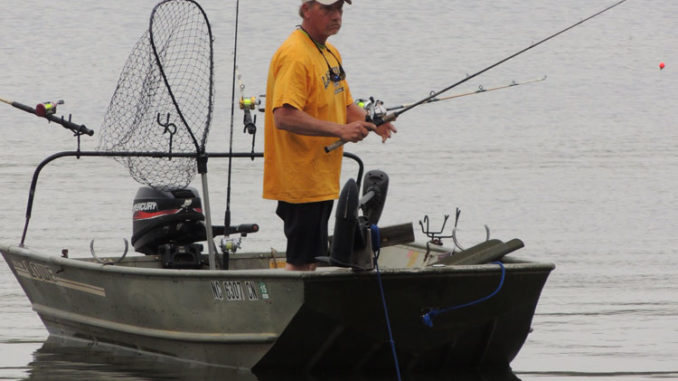
Smaller lakes, closer to home, are just the ticket for urban anglers.
You don’t need a big, expensive boat or a sprawling reservoir to enjoy great summer fishing if you’re a resident of North Carolina’s “Piedmont Triad” region, which includes Greensboro, Winston-Salem and High Point.
Municipal lakes in the three cities supply drinking water to residents and fishing fun for locals and tourists alike — from the shore, piers, rental skiffs or their own small boats.
One fisherman who is hooked on the small, city lakes, is Winston-Salem’s Robert Grubbs. After fishing Winston-Salem’s Salem Lake for 25 years, Grubbs, a skilled welder, proved himself a special kind of fisherman a decade ago.
On June 15, 2003, Grubbs, 50, observed Father’s Day on the 365-acre lake in style. He landed a 55-pound, 8-ounce flathead catfish just before dark to claim the lake record. The huge fish chomped down on a live crappie that Grubbs was fishing in less than six feet of water in sight of the lake’s only boat ramp.
“I fought that thing for about 30 minutes,” he said.
Visitors to Salem Lake’s fishing station still enjoy the results of that half-hour battle when they walk through the door a mount of Grubbs’ catfish dominates the wall that it shares with several other big fish.
Grubbs targets heavy catfish with 20-pound line on baitcasting outfits. He hooks a live bream or crappie on a Carolina-rig with a 16-inch leader and 2-ounce sinker, fishing several rods from his jonboat. Grubb has at least six 40-pound flatheads to his credit, including one trip several years ago when he had two hooked at the same time.
For Grubbs, Salem Lake offers a prime fishing hole just 15 minutes from his home. He occasionally competes in local bass tournaments, weighing in nice fish, and he catches plenty of bream and crappie for catfish bait.
“I really like Salem Lake,” he said. “This lake is close to home, and it has some big fish in it.”
Salem Lake reopened to anglers in last December after a two-year closure and 12-foot drawdown while a 90-year-old dam was replaced. Grubb said he’ll have to learn how to fish the lake all over again, because most of his shallow grass beds are gone.
“When the lake went down, it washed the creek channels out deeper,” he said. “That made it a bass heaven. For the catfish, I will have to figure it out, and that will be a challenge. In the summer, I can always find catfish near the aerators.”
Grubbs is not the only person facing a challenge at Salem Lake. Kin Hodges, a fisheries biologist for the N.C. Wildlife Resources Commission, will spend a lot of his time this year trying to see how the two-year drawdown, which reduced the lake to approximately 80 acres, affected the lake’s fish populations. Hodges said he samples the lake every two years or so, including 2010 — so he could get a “before” sample of the fishery. This year, he’ll be looking for an “after” sample when he electroshocks to study various species.
“The numbers of fish could be lower because they stayed in smaller pools of water,” he said. “Extreme drawdowns don’t happen very often, but we have seen that in other lakes.”
A case in point is Durham’s Lake Michie, he said. It’s often drawn down to the old creek channels in the fall during dry years. Bass respond by schooling in the remaining water, feeding on concentrated baitfish.
“You see a lot of fat bass in Lake Michie after a drawdown,” Hodges said. “I would expect the bass at Salem Lake to be healthy, but fewer in number. The bass had less water to spawn in for two years.”
The Commission normally stocks about 6,000 hybrid bass in Salem Lake annually but held off just before and during the drawdown. Hybrid stocking will resume this summer, he said.
Aquatic grass in Salem Lake offered cover for all of the game fish in the lake. During the drawdown, most of the grass died off, replaced by brush and shrubs.
“Once all that brush rots away, I hope the grass comes back, because it makes great fish habitat,” he said.
While electrofishing for bass, Hodges said, he will sometimes shock up some heavy flathead catfish in the shallow water. Local folklore holds that Commission staff stocked a few fingerling flatheads in Salem Lake in the 1980s when they were found in a hatchery truck that was being cleaned out after channel cats were stocked. The flatheads were leftovers from a stocking at another lake.
“I believe there is some truth to that,” Hodges said. “Today we would never introduce a new species in a lake, but that was common practice back then.”
Grubbs is certainly glad it was.
In Greensboro, anglers can choose from three city lakes, Higgins, Brandt and Townsend, all part of the Haw River that joins the Cape Fear near Sanford.
At 1,500 acres, Lake Townsend is the largest of the Greensboro city lakes. Local angler James Dawkins knows the lake after fishing it for more than 20 years. After all, he can be on the water after a 20-minute drive from home. If his boat’s in the shop, he can fish from the pier.
“Townsend is not that far from home,” he said. “I fish here a lot, and now I know the lake.”
Normally, Dawkins fishes for largemouth bass; his favorite summer technique is to slow roll a spinnerbait in 25 to 30 feet of water.
“I can catch a lot of 2- to 3-pound bass that way,” he said.
Dawkins is not above using live minnows to catch a mess of crappie, either, yet fishing here is more than a means to a fish fry.
“I like the challenge of seeing if I am a better predator than the fish,” he said. “This is my personal time to relax.”
Local anglers are not the only ones to take advantage of the Greensboro lakes. C.J. Plaster and his son, Mason, drive about an hour from Martinsville, Va., to target Lake Brandt’s largemouth bass. At home, they are serious fishermen, members of the Ridgeland Bass Anglesr Club, competing in tournaments in a Ranger bass boat. For the Greensboro lakes, they downsize to a 16-foot johnboat powered by a 55-pound-thrust trolling motor.
“I like to keep Mason on the water and fish different lakes,” C.J. Plaster said. “You never learn anything about bass fishing if you fish the same lake all the time.”
Lake Higgins is the smallest of the Greensboro city lakes, but it fishes big for the right angler with a small boat.
Philip Ruckart guides on Higgins and other area lakes from a kayak that comes equipped with depth finders and rod holders. Paddlers can troll or cast to suit the fish.
“During the summer I like to use spinnerbaits or crankbaits between eight and 12 feet down,” he said.
If that does not work, Ruckart uses his knowledge of the lakes to go even deeper.
“All of these city lakes are like bowls,” he said. “There is not a lot of structure on the bottom. A good way to catch bass at this time of year is Carolina rigs in the creek channels off of the main points.”
Down NC 68 in High Point, Ruckart used that technique to win a kayak bass contest on High Point City Lake near Jamestown. At 356 acres, City Lake is the smallest of two municipal reservoirs on the Deep River, part of the Cape Fear system.
Keith Trotter, who lives six miles from the lake, uses a 12-footer that he set up for these waters. Trotter began fishing here about 15 years ago. He eats channel catfish from the lake and uses his own technique to catch them.
“First, I catch bluegills with a fly rod,” he said. “Then, I use them for bait to catch catfish. During the summer, I like to go late in the day to avoid the heat.”
Up the river at Oak Hollow Lake, anglers can target bass, crappie, catfish and hybrids on this 800-acre reservoir. Some, like Raymond Brown from High Point, like to sit on the bank near the dock to work their lines. Like bank-fishing areas on several of the other lakes, anglers can cast around a fish feeder that attracts catfish and other species close to the shoreline. About every two hours, the devices broadcast fish food, and anglers such as Brown cast into the feeding frenzy in hopes of hooking up.
“I started fishing here about seven years ago,” Brown said. “It took me about three years to start catching fish. I keep refining my technique and read books to learn more.”
This bank-fishing expert uses an 11-foot spinning rod with 20-pound test line. For longer casts, he uses corks shaped like darts with fins. That figures, since he studies aerodynamic engineering at Guilford Technical Community College. His easy fishing spot is just a few miles from campus and a relaxing spot to unwind after class.
“This place is close to home with a nice view,” he said. “I make new friends here. We see all kinds of cool wildlife like blue herons and egrets.”
While he enjoys the view, he also likes the thrill of a big fish stretching his line. He mainly targets catfish and carp. On Sept. 22, Brown landed his name on the bragging board with a 14-pound channel catfish.
Oak Hollow may be the best city lake to land a largemouth bass for the bragging board, according to a 2010 study by the Commission. Using the shoreline electrofishing technique, biologists shocked an average of 72 bass per hour. The average range for lakes in this area is 30 to 60 bass per hour. Also, 60 percent of Oak Hollow’s bass measured 14 inches or longer.

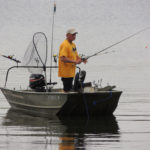
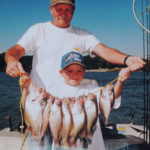
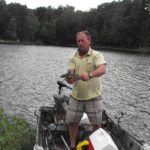
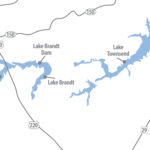
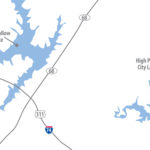
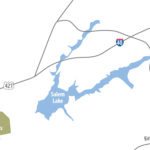

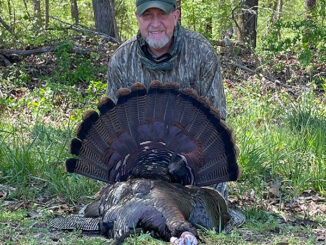

Be the first to comment